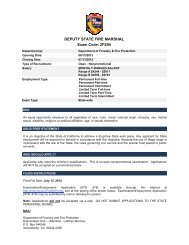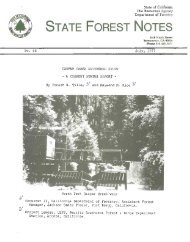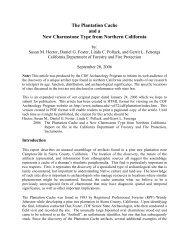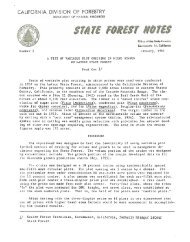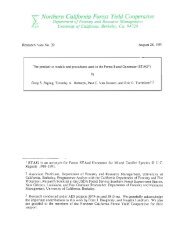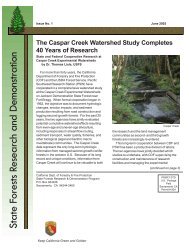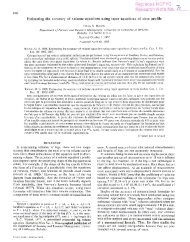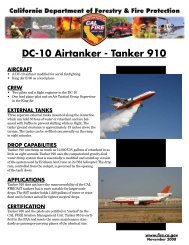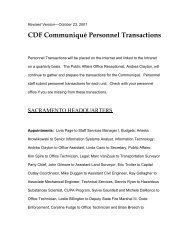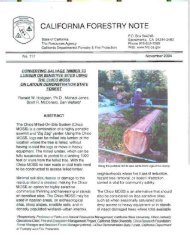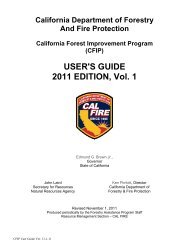Create successful ePaper yourself
Turn your PDF publications into a flip-book with our unique Google optimized e-Paper software.
2005 Riverside <strong>Unit</strong> Fire Management Plan<br />
Cottonwood Canyon is single and doublewide mobile homes. The hazards include,<br />
but are not limited to: Limited access and egress, limited water supply, and housing<br />
construction.<br />
The area south <strong>of</strong> Bundy Canyon Road may also pose a problem, however it is at<br />
least a north facing aspect. During north wind conditions, coupled with a wildland<br />
ignition, the potential exits for fire to rapidly spread south to Murrieta.<br />
Battalion 15 – Temecula<br />
Station 12 – Temecula<br />
Major assets at risk in the Temecula area include the De Luz area (A major<br />
Avocado producing region) inter-mixed with very high dollar housing and the Santa<br />
Margarita river drainage, which runs from Temecula to the Pacific Ocean. Old Town<br />
Temecula is also at risk, due to prevalent westerly afternoon winds, which have<br />
pushed fire downhill into Temecula in the past. Another area is the Pala/Temecula<br />
Grade, where there is a very heavy brush load, and an active real estate market has<br />
generated large, high dollar homes in the area. Additionally, a community <strong>of</strong><br />
homeless has set up a decent size encampment at the mouth <strong>of</strong> the Margarita<br />
drainage.<br />
The potential is here as everywhere in the county for a large high dollar fire.<br />
If there were a start in the Santa Margarita drainage or the Pala/Temecula Grade, it<br />
would be difficult to achieve an initial attack success, due to fuels, topography, and<br />
accessibility.<br />
Station 75 – Bear Creek<br />
The major assets risks within Station 75's Initial Attack area (SRA) include<br />
hundreds <strong>of</strong> residential structures with a minimum square footage <strong>of</strong> 4,000 feet up to<br />
a maximum <strong>of</strong> 12,000 square feet on five-acre parcels in the LaCresta and Tenaja<br />
area. This area is a significant watershed and environmental sensitive area. The<br />
6,500-acre Santa Rosa Nature Conservancy contains over 10 miles <strong>of</strong> roads only<br />
accessible by Type III engines is also entirely within Station 75’s initial attack area.<br />
Recreational areas include Tenaja Falls and a portion <strong>of</strong> the Wildomar Off Highway<br />
Vehicle area on the Cleveland National Forest, both <strong>of</strong> which are located in the Initial<br />
Attack area. There are also numerous equestrian facilities and trails in the LaCresta<br />
area.<br />
A significant potential for a large destructive wildfire exists within Station 75's<br />
area. This potential includes reasons listed above, a lack <strong>of</strong> any significant<br />
recorded fire history, and climatic conditions relating to the daily coastal influences.<br />
There are also several large communities with hundreds <strong>of</strong> significantly sized<br />
residences within the wildland urban interface and only two routes <strong>of</strong> ingress or<br />
egress in the event <strong>of</strong> an emergency. The general population frequently uses<br />
significant recreational areas and opportunities to access the National Forest areas.<br />
In the event <strong>of</strong> a wildfire there is a significant reflex time to augment required<br />
resources to affect evacuations and structure protection necessary in the area.<br />
35




